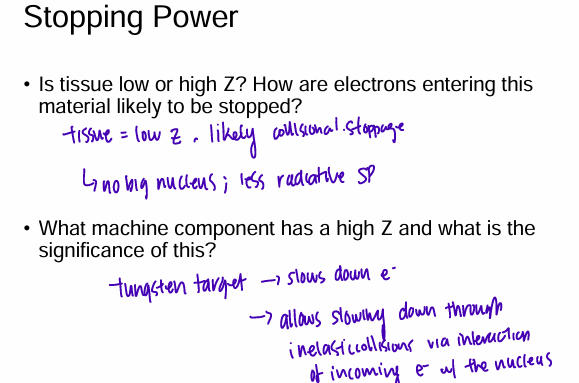11) e- beam
1/27
There's no tags or description
Looks like no tags are added yet.
Name | Mastery | Learn | Test | Matching | Spaced |
|---|
No study sessions yet.
28 Terms
Photons
no charge - indirectly ionizing (have to give up energy to something else)
no mass
“aka: ball of energy - kamehameha”
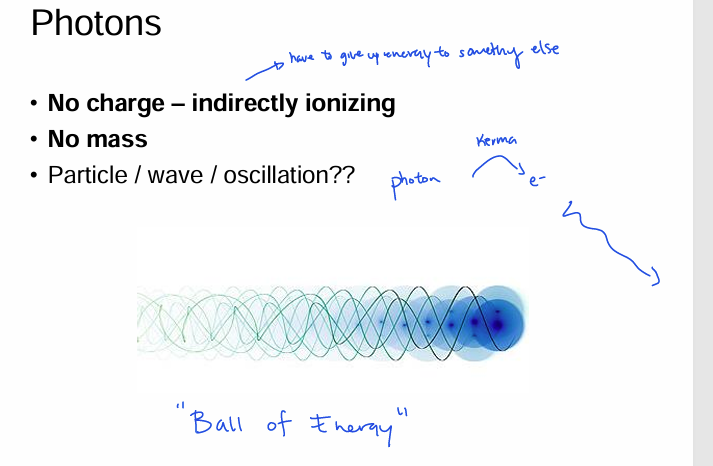
Electrons
charged mass - directly ionizing
mass
Why do we use e- beams?
superficial tx
-all e- likely to interact at the surface
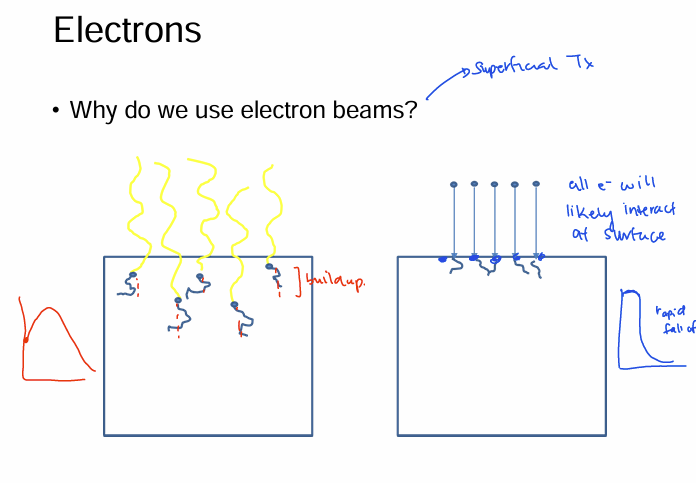
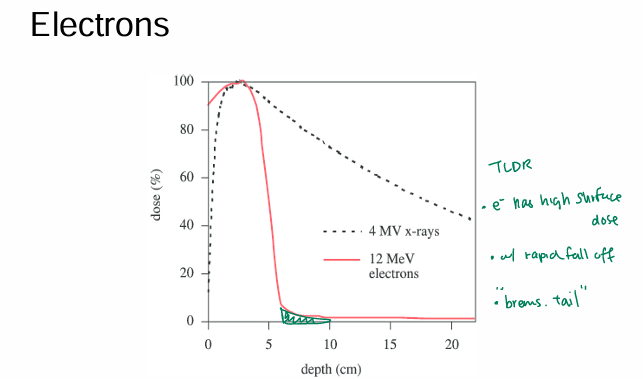
TLDR:
1) e- has high surface dose
2) rapid fall off
3) BSG tail (discussed later)
in contrast, photons/xray have lower fall off, b/c it penetrates more deeper in tissue
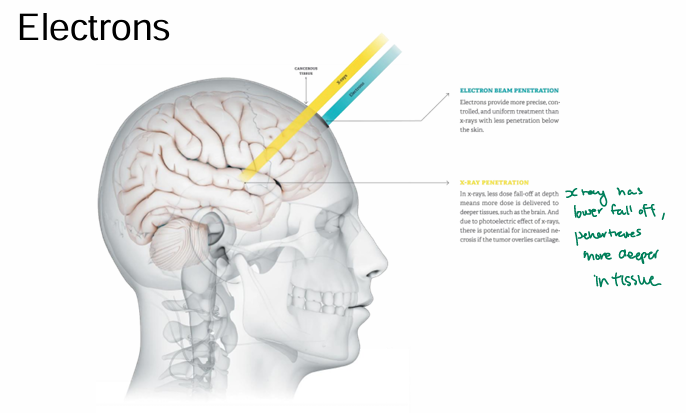
How do we produce an e- beam? How is it different from an xray beam?
1) remove x-ray target (so e- beam is like one line)
2) replace flattening filter w/ scattering filter
→ spreads that e- beam out
→ gives it a field size
3) e- applicator
- e- tend to scatter in air compared to photons
- applicator guides the beam (prevents scatter)
*4) ion chamber (checks for even distribution; but xray beam has this too)
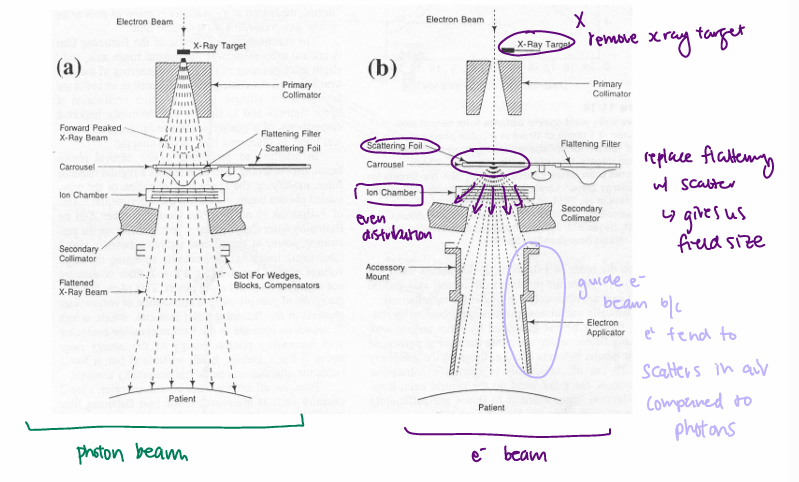
When doing our beam check with the ionization chamber (QA daily checks), what should we check for if we see that the beam doesn’t match what we inputted in e- mode?
check the scattering foil!
Discuss e- interactions
1) incoming e- (energetic) undergoes COULOMB INTERACTIONS w/ “absorbed” atoms
2) Could be interacting w/
- atomic orbital e-
- atomic nuclei (BSG xray)
What is meant by couloumb interactions?
electric field of e- interacts w/ other electric fields
As e- propagate through absorbing medium, they interact w/ ATOMS via:
- inelastic coulomb interactions or
- elastic coulomb interactions.
1) What is elastic collision?
2) What is inelastic collision?
3) What are we interested in for this course?
1) no change in energy of incoming e- (incident e-) → but changes direction
2) incident e- giving up (imparting) energy to another particle
3) inelastic

What does inelastic interactions depend on?
1) b = impact parameter
- distance of incoming e- from nucleus
2) a = radius
- radius of e- in that atom from the nucleus
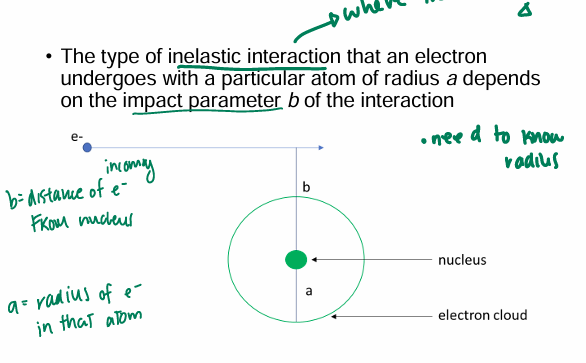
Discuss when b>>a for e- interactions
soft collision
→ small KE transfer
→ grimace costume BARELY touches
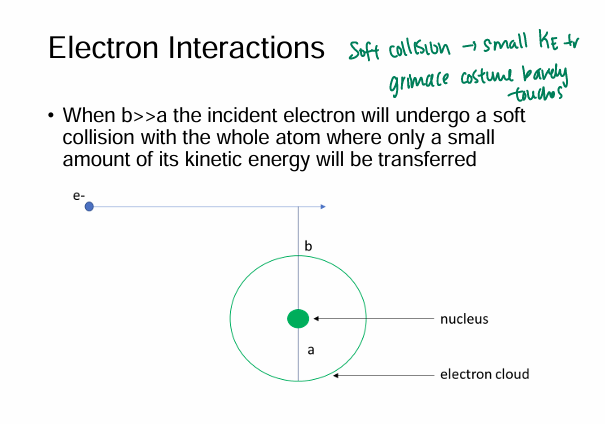
Discuss when b>a for e- interactions
hard collision
→ LARGE KE transfer
→ lots of KE from incoming e- transferred to orbital e-
→ causes ionization/excitations
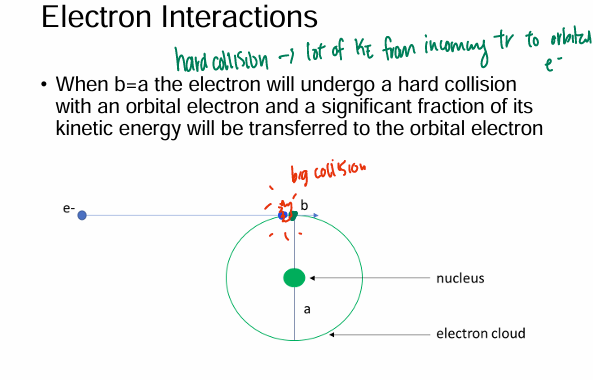
Discuss when b< < a
radiative collision
→ e- attracted to positive charge of nucleus
→ form BSG xray photon
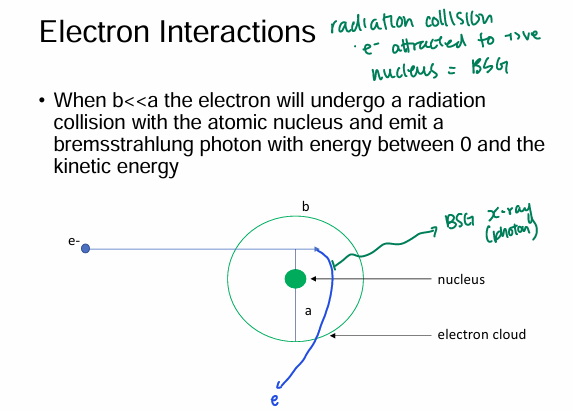
Inelastic collisions b/w incident e- and an orbital e- are coulomb interactions that result in __
1) atomic ionization
- ejection of orbital e- from absorber atom
2) atomic excitation
- orbital e- moved to higher level orbit
Both = collisional stopping power
What is collisional stopping power?
amt of energy it loses over given path via IONIZATION or EXCITIATION
Coulomb interactions b/w incident e- and absorber NUCLEUS results in __.
1) e- scattering & no energy loss (elastic collision)
2) e- scattering WITH KE LOSS in form of BSG = radiative stopping powerW
What is radiative stopping power?
ability of material to SLOW DOWN charged particle
What is LINEAR STOPPING POWER?
energy incident e- loses through inelastic collisions
(KE loss from e- per unit length [cm]) (MeV/cm)
TLDR: rate of energy loss
![<p>energy incident e- loses through inelastic collisions<br>(KE loss from e- per unit length [cm]) (MeV/cm)<br><br><span style="color: yellow"><strong>TLDR: rate of energy loss</strong></span></p>](https://knowt-user-attachments.s3.amazonaws.com/6fff20d4-d22a-408d-8e21-e972863be7a2.png)
What is TOTAL MASS STOPPING POWER?
Linear stopping power divided by DENSITY
- allows us to compare materials easier
Total mass stopping power has 2 components. What are they?
1) collisional stopping power from ionization/excitation
2) radiative stopping power from BSG production
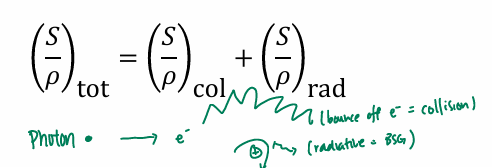
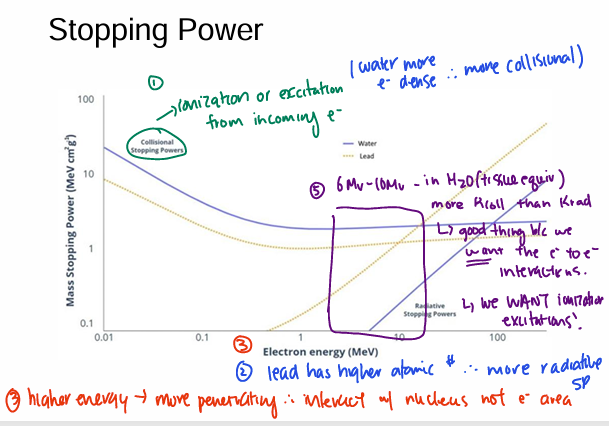
Summarize this graph:
1) Collisional stopping power = ionization or excitation from incoming e-
- water is more e- dense, therefore we see more collisional SP compared to lead
2) Radiative stopping power = BSG production via interaction/bending of e- due to nucleus
- Pb has higher atomic number, therefore more radiative SP compared to water
3) higher energy = more penetrating
- more interactions w/ nucleus, not the e- area
- as energy increases, we see radiative SP dominate (not collisional)
No4)
5) 6Mv-10Mv (is radiation therapy range)
- we see more Kcoll than Krad
→ good thing b/w WE WANT the e- to e- interactions.
→ we WANT those ionizations and excitations!
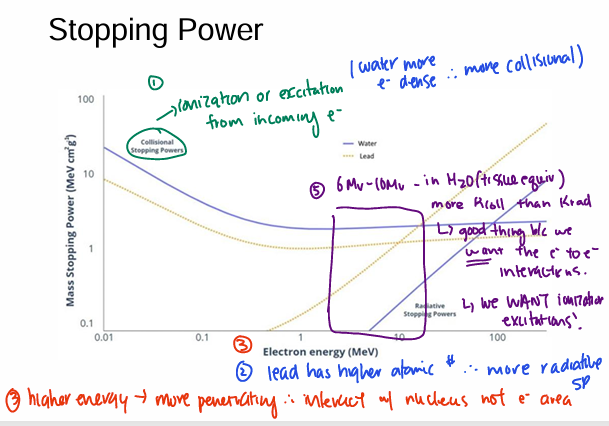
When is collisional stopping power dominant?
KE below 10MeV
*note: situation is reversed at higher energies
(b/c BSG x ray higher w/ high energy, therefore more radiative)
What is it called when 2 stopping powers are equal?
critical kinetic energy
The rate of energy loss for therapeutic e- beam in water is what?
2MeV/cm
-therefore 12 MeV beam can only travel 6cm
—
ans to q = 3cm
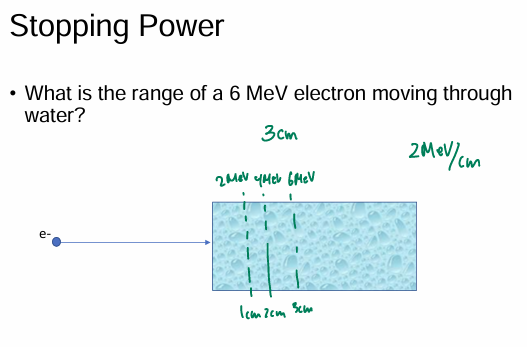
What does the rate of energy loss for collision interactions depend on (Collisional SP)
1) KE of incoming e-
2) e- density of absorbed (atom’s e- density)
Ex. H20 has higher e- density (more likely for incoming e- to hit an orbital e-)
- Pb has less e- dense b/c massive nucleus, therefore probability of e-to e- is unlikely
What does the rate of energy loss for RADIATIVE interactions depend on (Radiative SP)
1) KE of incoming e-
2) Atomic #/ size of the absorber (makes sense)
Summary:
Total energy loss by e- traversing an absorber depends on…
1) KE energy of e-
- affects both radiative and collision
2) Size/atomic # of absorber
- affects radiative
3) e- density
- affects collision
